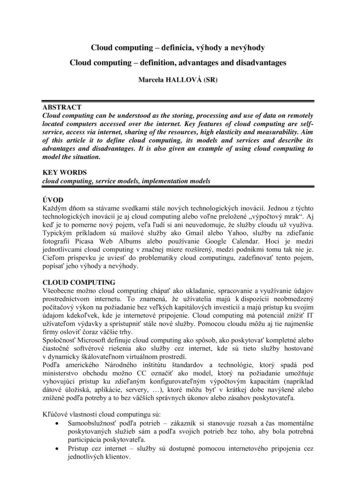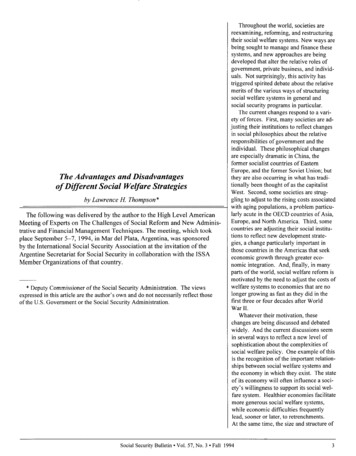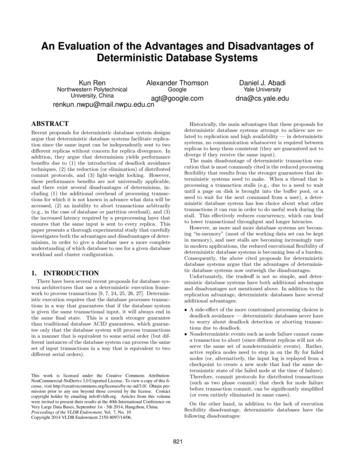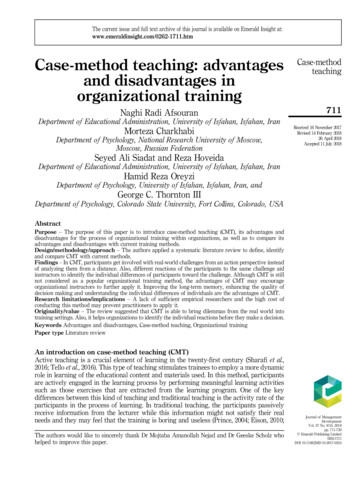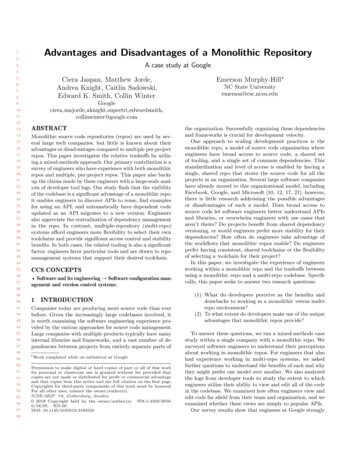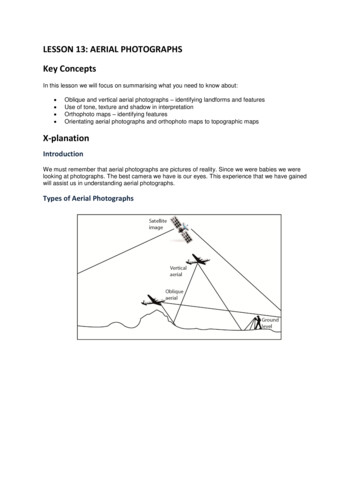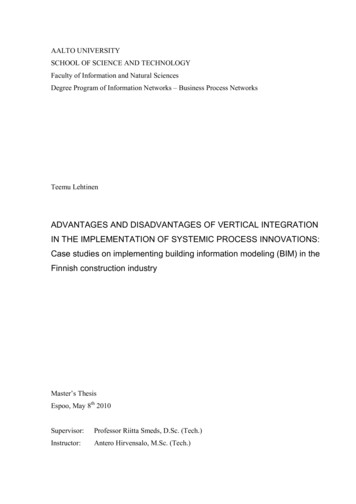
Transcription
AALTO UNIVERSITYSCHOOL OF SCIENCE AND TECHNOLOGYFaculty of Information and Natural SciencesDegree Program of Information Networks – Business Process NetworksTeemu LehtinenADVANTAGES AND DISADVANTAGES OF VERTICAL INTEGRATIONIN THE IMPLEMENTATION OF SYSTEMIC PROCESS INNOVATIONS:Case studies on implementing building information modeling (BIM) in theFinnish construction industryMaster’s ThesisEspoo, May 8th 2010Supervisor:Professor Riitta Smeds, D.Sc. (Tech.)Instructor:Antero Hirvensalo, M.Sc. (Tech.)
Aalto UniversitySchool of Science and TechnologyABSTRACT OF THE MASTER’S THESISFaculty of Information and Natural SciencesDegree Program of Information NetworksAuthor:Teemu LehtinenTitle: Advantages and disadvantages of vertical integration in the implementation of systemic process innovations:Case studies on implementing building information modeling (BIM) in the Finnish construction industryNumber of Business and service processes in digital r Riitta Smeds, D.Sc. (Tech.)Antero Hirvensalo, M.Sc. (Tech.)Abstract:Vertical integration refers to a combination of several or all functions in the value chain under a single firm. Manyresearchers have suggested that vertical integration facilitates the development and implementation of systemicinnovations. As opposed to autonomous innovations that can be introduced as such without any major changes ormodifications to the rest of the business system, systemic innovations require significant adjustments in other partsof the business system in order to be implemented successfully. However, systemic innovations are often toocomplex and large to manage and coordinate under a single integrated firm.Building information modeling (BIM) is an example of a systemic process innovation in the construction industry.BIM is a set of interacting policies, processes, and technologies generating a methodology to manage the essentialbuilding design and project data in digital format throughout the life-cycle of a building. BIM has been expected tobring significant improvements in productivity in the construction industry since the 1980’s but theimplementation and diffusion of BIM have been proved to be slower and more difficult than expected, largely dueto its interorganizational and systemic nature. At the same time, there has been a trend of vertical integration in theconstruction industry in recent years. This study aims to shed more light on the connection between BIMimplementation and the organizational structure, and examines the advantages and disadvantages of verticalintegration in the implementation of BIM as an example of a systemic process innovation.The empirical research is based on two opposite case studies from the Finnish construction industry; a verticallydisintegrated project network and a vertically integrated project network. Both case studies included a singleconstruction project where BIM was being implemented. The qualitative data consists of project documentation,interviews, and observations. A theoretical model of the advantages and disadvantages of vertical integration isfirst constructed based on the literature review. The model is later tested with the empirical data and refined into animproved model based on the analysis.The findings of the study propose that there are seven structurally relevant factors in BIM implementation; (1)management support, (2) coordination and control, (3) learning and experience, (4) technology management, (5)communication, (6) motivation, and (7) defining roles. There are both advantages and disadvantages of verticalintegration related to each of these implementation factors. Thus, in order to achieve as smooth implementation aspossible, managers should understand the impact of the organizational structure in BIM implementation and planthe implementation projects accordingly.Keywords: vertical integration, technology implementation, systemic process innovation, building informationmodeling (BIM), construction industry
Aalto-yliopistoTeknillinen korkeakouluDIPLOMITYÖN TIIVISTELMÄInformaatio- ja luonnontieteiden tiedekuntaInformaatioverkostojen tutkinto-ohjelmaTekijä:Teemu LehtinenTyön nimi: Vertikaalisen integraation hyödyt ja haitat systeemisten prosessi-innovaatioiden käyttöönotossa:Tapaustutkimuksia rakennusten tietomallinnuksen (BIM) käyttöönotosta Suomen iiketoiminta- ja palveluprosessit tietoverkoissaT-124Työn valvoja:Professori, TkT Riitta SmedsTyön ohjaaja:DI Antero HirvensaloenglantiTiivistelmä:Vertikaalinen integraatio tarkoittaa usean tai kaikkien arvoketjun toimintojen yhdistymistä samaan yritykseen.Monet tutkijat ovat olleet sitä mieltä, että vertikaalinen integraatio edistää systeemisten innovaatioidensynnyttämistä ja käyttöönottoa. Kun tavalliset innovaatiot voidaan ottaa käyttöön sellaisenaan ilman sen suurempiamuutoksia laajempaan toimintaympäristöön, systeemisten innovaatioiden menestyksekäs käyttöönotto vaatiimerkittäviä muutoksia koko toimintaympäristössä. Usein systeemiset innovaatiot ovat kuitenkin liianmonimutkaisia ja laajoja yhden yrityksen hallittavaksi.Rakennusten tietomallinnus (BIM) on esimerkki systeemisestä prosessi-innovaatiosta rakennusalalla.Tietomallinnus tarkoittaa laajaa kokonaisuutta, joka koostuu yhteisistä käytännöistä, prosesseista ja teknologioista.Tietomallinnuksen tarkoituksena on hallita rakennukseen liittyvää tietoa digitaalisessa muodossa rakennuksenkoko elinkaaren ajan aina suunnittelusta toteutukseen ja käyttöön. Tietomallinnuksen on odotettu tuovanmerkittäviä parannuksia rakennusalan tuottavuuteen jo 80-luvulta lähtien, mutta sen käyttöönotto ja leviäminen onosoittautunut ennakoitua hitaammaksi ja vaikeammaksi. Keskeisenä syynä tähän on ollut tietomallinnuksensysteeminen ja organisaatioiden rajat ylittävä luonne. Samalla kuitenkin, myös kiinnostus vertikaaliseenintegraation on lisääntynyt rakennusalalla. Tämä tutkimus pyrkiikin valottamaan tietomallinnuksen käyttöönotonja organisaatiorakenteiden välistä yhteyttä tutkimalla vertikaalisen integraation hyötyjä ja haittojatietomallinnuksen käyttöönotossa.Tutkimuksen empiirinen osa perustuu kahteen vastakkaiseen tapaustutkimukseen Suomen rakennusteollisuudessa.Toisessa tapauksessa projektiverkosto koostui erillisistä yrityksistä, kun taas toisessa tapauksessa projektiverkostooli vertikaalisti integroitunut. Molemmissa tapauksissa tarkasteltiin yksittäistä rakennushanketta, jossa testattiintietomallinnusta. Laadullinen tutkimusaineisto koostuu projektidokumentaatiosta, haastatteluista sekä osapuolienhavainnoinnista. Tutkimuksessa luodaan ensin teoreettinen malli vertikaalisen integraation hyödyistä ja haitoistaperustuen kirjallisuuskatsaukseen. Tämän jälkeen mallia testataan tutkimusaineistolla ja parannellaan analyysinperusteella.Tutkimuksen tulosten perusteella tietomallinnuksen käyttöönottoon liittyy seitsemän organisaatiorakenteenkannalta merkittävää tekijää. Nämä tekijät ovat (1) johdon tuki, (2) koordinointi ja hallinta, (3) oppiminen jakokemus, (4) teknologian hallinta, (5) viestintä, (6) motivaatio sekä (7) roolien määrittely. Kaikkiin näihintekijöihin liittyy vertikaalisen integraation tuomia hyötyjä ja haittoja. Tämän vuoksi yritysjohdon pitäisikinymmärtää organisaatiorakenteen mahdolliset vaikutukset tietomallinnuksen käyttöönotossa, jottakäyttöönottoprojektit osattaisiin suunnitella ja toteuttaa mahdollisimman sujuvasti.Asiasanat: vertikaalinen integraatio, teknologian käyttöönotto, systeeminen prosessi-innovaatio, rakennustentietomallinnus (BIM), rakennusteollisuus
AcknowledgementsThis journey has finally come to an end. And what a ride it has been! This Master’s Thesishas been written during the ECPIP Finland research project in the Enterprise SimulationLaboratory SimLab of the Aalto University School of Science and Technology. I would liketo express my deepest gratitude to everyone who has contributed to this work along the way.The ECPIP Finland project has given me an extraordinary chance to dive into the fascinatingworld of research in the complex context of the construction industry. The project has takenme to Stanford University in California and to GSA in Washington DC. I have met an incredible amount of researchers and construction industry professionals both in Finland andabroad. In fact, I have personally met 18 authors from the reference list of this thesis duringthe project. That’s amazing! I really want to thank Tekes, VTT, and all the participating firmsfor making this project possible.SimLab has provided an excellent environment to find out what academic research is allabout. I want to thank professor Riitta Smeds, the supervisor of my thesis, for all the opportunities and of course the guidance and support in writing this thesis. I am also deeply gratefulto my instructor, Antero Hirvensalo, for great advice and comments when I needed them themost. Working at SimLab wouldn’t have been the same without all the great co-workers. Special thanks to my teammates in ECPIP Finland: Hanna Björkstrand, Kaarina Kaste, Juha Kujala, Antti Maunula, and Sami Ruotsalainen. And all the rest SimLabbers, present and past,thanks for making it so much fun!Finally, I want to thank my family for all the love and support during my studies and throughout my whole life. And all my friends, thanks for understanding my busy schedule and stressful state of mind. Hopefully now, I got some more time for you again! And last but definitelynot least, I want to thank my beautiful wife, Jessica, for never-ending love and support. Without you, all of this would have been meaningless.Let the next journey begin!Teemu LehtinenEspoo, May 8th 2010
Table of ContentsIINTRODUCTION . 11BACKGROUND AND MOTIVATION. 12FOCAL CONCEPTS AND THE CONTEXT OF THE STUDY . 42.1Vertical integration . 42.2Systemic process innovation . 72.3Construction industry . 102.4Building information modeling (BIM) . 133RESEARCH PROBLEM, OBJECTIVES AND SCOPE. 164RESEARCH APPROACH . 175II4.1Case study research . 174.2Action research . 184.3Constructive research . 194.4Research process. 20STRUCTURE OF THE STUDY . 21LITERATURE REVIEW . 23678ADVANTAGES AND DISADVANTAGES OF VERTICAL INTEGRATION . 236.1General advantages and disadvantages of vertical integration . 236.2Vertical integration and systemic innovations. 336.3Vertical integration in the construction industry . 35IMPLEMENTATION OF SYSTEMIC PROCESS INNOVATIONS . 397.1Implementing organizational and operational change . 397.2Implementing collaboration technologies . 427.3Implementing systemic innovations in the construction industry . 47SYNTHESIS OF THE LITERATURE REVIEW . 538.1Summary of the literature review . 538.2Constructed theoretical model . 578.3The detailed research question . 62
III EMPIRICAL RESEARCH. 63910DESCRIPTION OF THE CASES. 639.1Background of the cases . 639.2Case descriptions . 649.3Key differences of the cases . 69DATA COLLECTION AND ANALYSIS METHODS . 7010.1SimLab business process development method . 7010.2Data collection methods . 7210.3Data analysis methods . 79IV FINDINGS. 8211ADVANTAGES AND DISADVANTAGES OF VERTICAL INTEGRATION IN BIMIMPLEMENTATION . 8212V11.1Management support . 8211.2Coordination and control . 8411.3Learning and experience. 8811.4Technology management . 9111.5Communication . 9411.6Motivation . 9611.7Additional factor: Defining roles. 97IMPROVED THEORETICAL MODEL . 101DISCUSSION . 10513CONCLUSIONS . 10514THEORETICAL IMPLICATIONS . 10815MANAGERIAL IMPLICATIONS . 11116EVALUATION OF THE RESEARCH . 11217FUTURE RESEARCH . 115
List of FiguresFigure 1: The concept of vertical integration (adapted from Porter 1980).5Figure 2: The difference between autonomous and systemic innovation (Maula et al. 2006, 247) .8Figure 3: Typical organizational boundaries between the participants in a construction project(modified from Eastman et al. 2008, 3) .11Figure 4: From paper-based set of plans to virtual model (modified from Taylor 2007, 995) .14Figure 5: BIM maturity stages (modified from Succar 2009, 363) .15Figure 6: Elements of constructive research (Kasanen et al. 1993, 246) .19Figure 7: The research process of the study .20Figure 8: The structure of the study .21Figure 9: Matching organization to the type of innovation (Chesbrough & Teece 2002, 132) .34Figure 10: The categories of factors influencing implementation of collaboration technologies(Munkvold 2003, 64) .43Figure 11: Innovation processes in the construction industry (Winch 1998, 273) .48Figure 12: The framework for a successful 3-D CAD implementation in the construction industry(Taylor 2007, 1000) .51Figure 13: Case Alpha – Vertically disintegrated project network .66Figure 14: Case Beta – Vertically integrated project network .68Figure 15: The SimLab process simulation project (adapted from Smeds et al. 2005, 342).71Figure 16: The interactive process of qualitative data analysis (Miles & Huberman 1994, 12) .80Figure 17: The distribution of the quotes under different implementation factors .81Figure 18: Improved theoretical model – The advantages and disadvantages of vertical integration inBIM implementation .102
List of TablesTable 1: Summary of the general advantages and disadvantages of vertical integration .32Table 2: Summary of the advantages and disadvantages of vertical integration in the context ofsystemic innovations .35Table 3: Summary of the advantages and disadvantages of vertical integration in the context of theconstruction industry .38Table 4: Problems, implications and related action steps for change management (Nadler 1981) .40Table 5: Potential success factors of change management (Salminen 2000, 97) .41Table 6: Implementation factors related to the organizational context (Munkvold 2003, 66) .44Table 7: Implementation factors related to the implementation project (Munkvold 2003, 68) .45Table 8: Implementation factors related to the collaboration technology (Munkvold 2003, 70) .46Table 9: Implementation factors related to the implementation process (Munkvold 2003, 76) .47Table 10: The four constructs affecting the implementation of systemic innovations (adapted fromTaylor & Levitt 2004) .49Table 11: Constructed theoretical model – The advantages and disadvantages of vertical integration inthe implementation of systemic process innovations .58Table 12: The key differences between the case studies .70Table 13: Empirical data from Case Alpha used in this thesis .75Table 14: Empirical data from the first process simulation in Case Beta used in this thesis .77Table 15: Empirical data from the second process simulation in Case Beta used in this thesis .79Table 16: The findings related to the management support .84Table 17: The findings related to the coordination and control .88Table 18: The findings related to the learning and experience .91Table 19: The findings related to the technology management .94Table 20: The findings related to the communication .96Table 21: The findings related to the motivation .97Table 22: The impact of the findings in the constructed theoretical model .100
List of AppendicesAppendix 1: The pre-planned questionnaire for the interviews
List of Acronyms2-D CAD2-Dimensional Computer Aided Design3-D CAD3-Dimensional Computer Aided Design4-D CAD4-Dimensional Computer Aided Design (3-D time)5-D CAD5-Dimensional Computer Aided Design (3-D time and cost)AECOArchitecture, Engineering, Construction and OperationsBIMBuilding Information ModelingBUBusiness UnitCADComputer Aided DesignCAMComputer Aided ManufacturingCIFECenter for Integrated Facility EngineeringECPIPEngineering and Construction Project Information PlatformFMFacilities ManagementGDPGross Domestic ProductGSAU.S. General Services AdministrationIAIInternational Alliance for InteroperabilityICTInformation and Communication TechnologyIFCIndustry Foundation ClassesIPDIntegrated Project DeliveryITInformation TechnologyMEPMechanical, Electrical, and PlumbingMgmtManagementNIBSThe National Institute of Building SciencesNVDNew Venture DevelopmentOECDOrganisation for Economic Co-operation and DevelopmentTCETransaction Cost EconomicsTekesThe Finnish Funding Agency for Technology and InnovationTKKHelsinki University of TechnologyVDCVirtual Design and ConstructionVTTTechnical Research Centre of Finland
Teemu Lehtinen: Advantages and Disadvantages of Vertical Integration in the Implementation of Systemic Process InnovationsIINTRODUCTION千 里 之 行 始 于 足 下“A long march starts from the very first step.”– Ancient Chinese proverbThis introductory part presents the point of departure and the content of this Master’s Thesis.The part consists of five chapters; background and motivation (Chapter 1), focal concepts andthe context of the study (Chapter 2), research problem, objectives and scope (Chapter 3), research approach (Chapter 4), and structure of the study (Chapter 5). Overall, the purpose ofthis part is to describe the starting point of this thesis before submerging into the literature review in Part II.1Background and motivationMany organizations struggle with their make-or-buy decisions as there is usually more in itthan just economic profitability considerations. The concept of vertical integration is fundamentally based on these decisions, and thus, it determines where the organizational boundaries are drawn in a given situation. Traditionally, the term vertical integration has been understood as the degree of ownership of different functions along the value chain of a productor a service (Fergusson 1993, 28). Improved coordination, increased control, and various advantages from synergies are often cited as the main benefits of being a vertically integratedorganization (e.g. Harrigan 1984, 639). Historically, vertical integration has played an especially important role during the creation of new industries where the existing market has notnecessarily been capable of satisfying the demands of an emerging industry (e.g. Afuah2001). However, as an industry matures and competition evolves, the incentives for verticalintegration usually decrease as it may be more cost-efficient to buy needed products or services from the market rather than to produce them in-house.The development of information and communication technology (ICT) has, however, had itseffect on the concept of vertical integration. With ICT it is possible to achieve at least some ofthe benefits of vertical integration without the actual ownership of different business unitsalong the value chain. Some researchers have even started to talk about digital vertical integration meaning that interorganizational ICT systems could enable separate organizations tocollaborate together in a similar way as internal business units do in a traditional vertically1
Teemu Lehtinen: Advantages and Disadvantages of Vertical Integration in the Implementation of Systemic Process Innovationsintegrated firm (e.g. Davies et al. 2009, 112). Accordingly, many researchers have predicted –especially before the burst of the dot-com bubble in 2001 – the fall of traditional verticallyintegrated organizations and the rise of networked, vertically disintegrated firms that wouldconcentrate solely on their core competence and outsource everything else (e.g. Brynjolfssonet al. 1994; Evans & Wurster 2000). As this prediction still lives on, it has not been fully realized yet as firms will still want to keep strict control of the flow of their information andphysical goods. In addition, the complex ICT systems and the collaboration between firms areafter all created and managed by people, which means that there is always some inherent friction present such as development and implementation difficulties or risk and reward sharingissues (Singh 2005). In fact, there even seems to be newly arisen interest towards traditionalvertical integration within many industries recently (Worthen et al. 2009).In recent years, researchers have started to call complex interorganizational ICT systems ofthis kind as systemic innovations (e.g. Lee & Chang 2007; Maula et al. 2006; Taylor & Levitt2004). As opposed to autonomous innovations that can be introduced as such without any major changes or modifications to the rest of the business system, systemic innovations requiresignificant adjustments in other parts of the business system in order to be implemented successfully (e.g. De Laat 1999, 159-160; Maula et al. 2006, 241-242; Teece 1996, 205). In addition to the complex ICT systems, other examples of systemic innovations from the literatureinclude instant photography, front-wheel drive, a jet airliner, and audio CD (Teece 1996).Since systemic innovations impact multiple actors in the business system, special attentionneeds to be given to the coordination between different actors (Teece 1996, 219). As the organizational structure has its influence on the coordination, researchers have suggested thatcertain organizational structures facilitate the development and implementation of certaintypes of innovations (e.g. Chesbrough & Teece 2002; Cooper 1998; Teece 1996). More specifically, vertical integration has been said to facilitate systemic innovations by removing theinstitutional barriers, and thus, facilitating the overall coordination (Armour & Teece 1980;Chesbrough & Teece 2002; Langlois 1992; Taylor & Levitt 2004; Teece 1996). Therefore,somewhat paradoxically, an interorganizational ICT system which is an example of a systemic innovation and enables digital vertical integration, in fact, requires traditional vertical integration in order to be successfully implemented and diffused. The empirical evidence supporting this view is, however, quite limited and some researchers have even come up with contradictory arguments. The main opposing argument seems to be the fact that most systemic innovations are too complex and large for any vertically integrated company to manage alone2
Teemu Lehtinen: Advantages and Disadvantages of Vertical Integration in the Implementation of Systemic Process Innovationsanyway (De Laat 1999; Maula et al. 2006). Nevertheless, more research is needed in this areato find out if some degree of vertical integration is indeed a facilitating factor.This Master’s Thesis aims to shed more light on the dynamics between vertical integrationand systemic innovations. The motivation for this study emerged from ECPIP Finland (Engineering and Construction Project Information Platform) research project where the implementation of building information modeling (BIM) was studied in the contexts of both verticallydisintegrated and vertically integrated project networks in the Finnish construction industry.BIM is a textbook example of a systemic process innovation and refers to different technologies and processes that enable different actors of a construction project network to collaborateand develop a virtual model of the planned building (Taylor & Bernstein 2009, 69; Taylor2007, 995). Vision after vision, BIM has been expected to bring significant improvements inproductivity in the construction industry. In fact, tools and processes for BIM have been developed since the 1980’s (Penttilä 2006, 403) but the actual implementation and diffusionhave been proved to be slower and more difficult than expected, largely due to its interorganizational and systemic nature (e.g. Fischer & Kam 2002; Fox & Hietanen 2007; Taylor & Levitt 2004; Taylor & Levitt 2007; Taylor 2007). Interestingly now, when BIM is gaining momentum again, there seems to be a trend of vertical re-integration within the construction industry (e.g. Cacciatori & Jacobides 2005; Lukkari 2008). Coincidence or not, it supports theobjective of this thesis to examine closer the impact of vertical integration in the implementation of BIM. Furtherm
construction project where BIM was being implemented. The qualitative data consists of project documentation, interviews, and observations. A theoretical model of the advantages and disadvantages of vertical integration is first constructed based on the literature review. The model is later tested with the empirical data and refined into an

